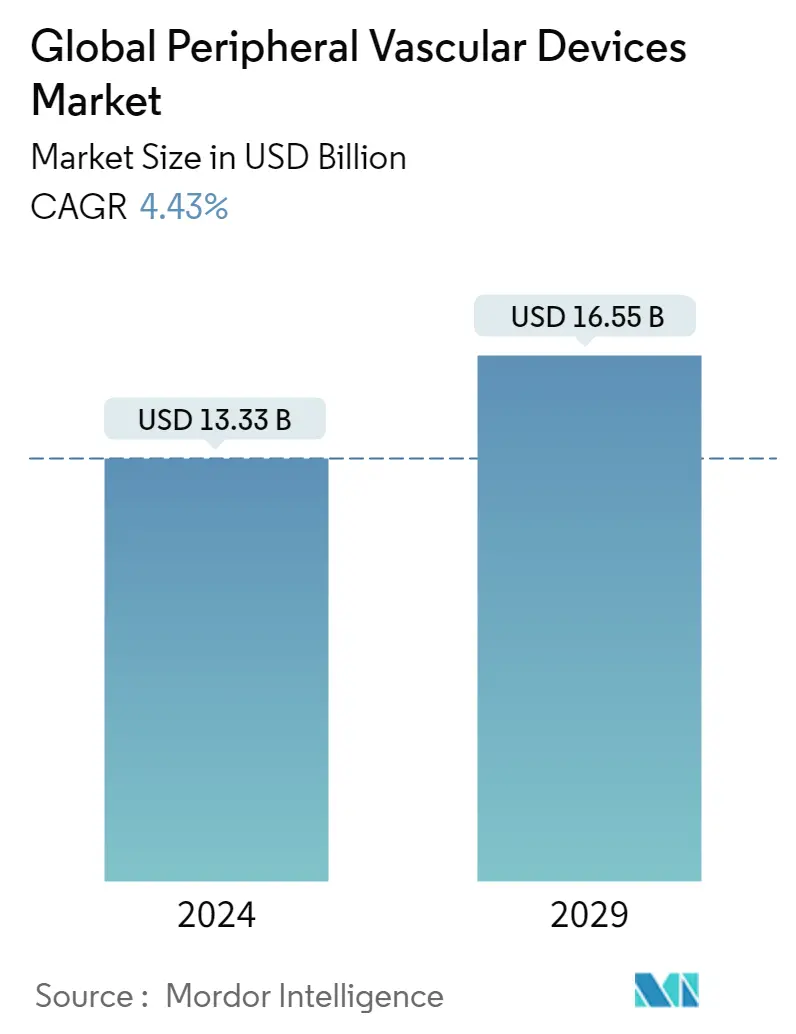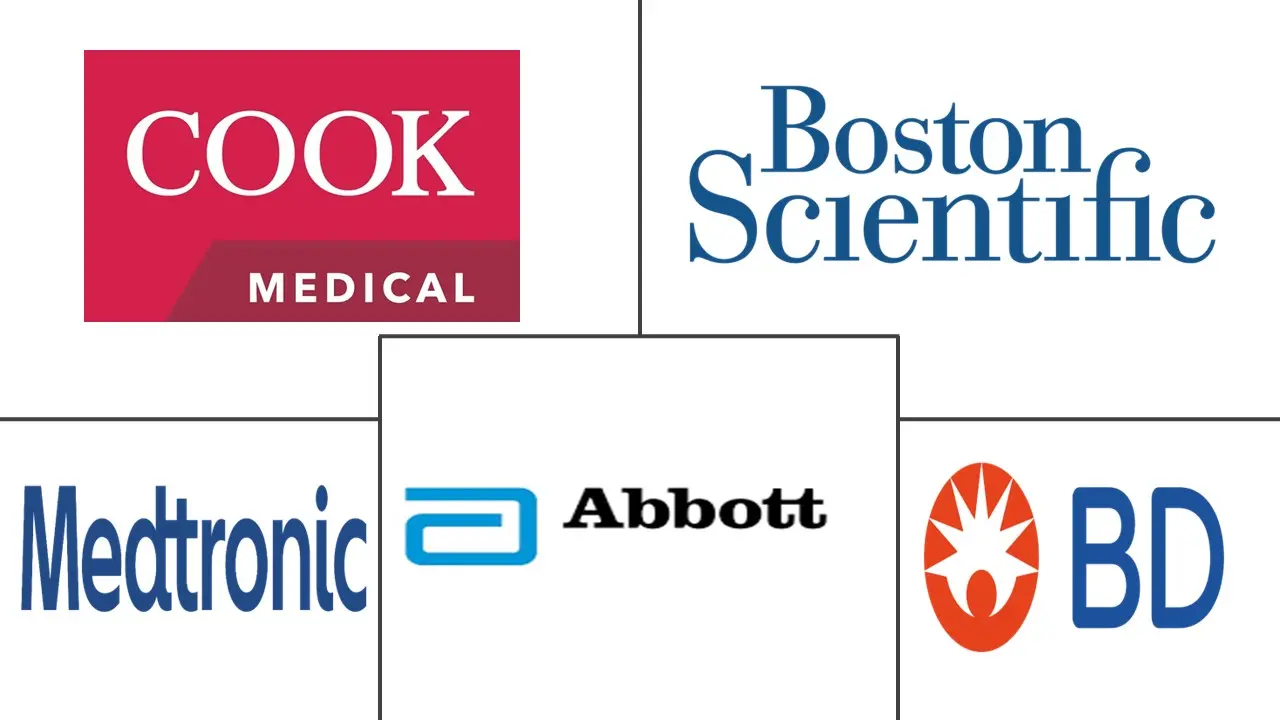Market Size of Global Peripheral Vascular Devices Industry

| Study Period | 2019 - 2029 |
| Market Size (2024) | USD 13.33 Billion |
| Market Size (2029) | USD 16.55 Billion |
| CAGR (2024 - 2029) | 4.43 % |
| Fastest Growing Market | Asia Pacific |
| Largest Market | North America |
Major Players
*Disclaimer: Major Players sorted in no particular order |
Peripheral Vascular Devices Market Analysis
The Global Peripheral Vascular Devices Market size is estimated at USD 13.33 billion in 2024, and is expected to reach USD 16.55 billion by 2029, growing at a CAGR of 4.43% during the forecast period (2024-2029).
The COVID-19 pandemic negatively affected the treatment and diagnostics procedures other than COVID-19 which had a significant impact on the studied market as it not only affected diagnostic and treatment procedures but also research and development activities in the area. Further, many studies suggested that people with cardiac diseases were at major risk from COVID-19, which further led to the reduction in footfall in hospitals and diagnostic centers. For instance, according to the research study titled 'Impact of COVID-19 on cardiac procedure activity in England and associated 30-day mortality' published by the National Center for Biotechnology Information in May 2021, during the COVID-19 pandemic, cardiac procedural activity in England decreased dramatically, with a deficit of about 45,000 procedures, with no increase in the risk of mortality for most cardiac procedures conducted during the pandemic. This study shows the negative impact of COVID-19 on cardiology services. Further, the study was conducted in England.
However the market started to gain traction as the COVID-19 cases declined and the lockdowns were taken off. For instance, according to the Australian Institute of Health and Welfare May 2022, out of 11.8 million admissions, 7.0% of hospitalizations involved a stay in the intensive care unit, and 3.8% of hospitalizations involved Cardio vascular diseases. Such increasing admission in emergency and critical care created the need for the availability of arterial blockage treatment and this is expected to drive the growth of the peripheral vascular devices market studied over the analysis period.
In addition to it, rising demand for minimally-invasive procedures and an increase in the incidence of peripheral arterial disease (PAD) are actively affecting the growth of the studied market.
According to the American Heart Association 2021 report, Peripheral artery disease (PAD) affects more than 200 million people worldwide and is associated with high mortality and morbidity. With the aging global population, it is likely that PAD may be increasingly common in the future. Hence, the statistics show that the number of PAD is increasing at a faster pace, which is ultimately driving the market for peripheral vascular devices.
A Scientific study titled 'Lower Extremity Peripheral Artery Disease: Contemporary Epidemiology, Management Gaps, and Future Directions' published by the American Heart Association in August 2021 stated that lower extremity peripheral artery disease (PAD) affects more than 230 million persons worldwide and is linked to an elevated risk of a number of unfavorable clinical outcomes (including cardiovascular diseases like coronary heart disease and stroke and limb outcomes like amputee status). The increased incidence of PAD is ultimately boost the peripheral vascular devices market over the forecast period.
Therefore, owing to the aforementioned factors the studied market is anticipated to witness growth over the analysis period. However, the high cost of installation and maintenance is likely to impede the market growth.
Peripheral Vascular Devices Industry Segmentation
As per the scope of the report, vascular devices can be referred to as medical devices which are utilized in the case of catheterization post cardiovascular surgery, for the closure and achieving hemostasis in the artery. The peripheral vascular devices market is segmented by device type (peripheral vascular stents, peripheral transluminal angioplasty (PTA) balloon catheters, peripheral transluminal angioplasty (PTA) guidewires, atherectomy devices, embolic protection devices, inferior vena cava filters, and other device types) and geography (North America, Europe, Asia-Pacific, Middle-East and Africa, and South America). The market report also covers the estimated market sizes and trends for 17 different countries across major regions, globally. The report offers the value (in USD million) for the above segments.
| By Device Type | |
| Peripheral Vascular Stents | |
| Peripheral Transluminal Angioplasty (PTA) Balloon Catheters | |
| Peripheral Transluminal Angioplasty (PTA) Guidewires | |
| Atherectomy Devices | |
| Embolic Protection Devices | |
| Inferior Vena Cava Filters | |
| Other Device Types |
| Geography | ||||||||
| ||||||||
| ||||||||
| ||||||||
| ||||||||
|
Global Peripheral Vascular Devices Market Size Summary
The peripheral vascular devices market is poised for growth, driven by an increasing demand for minimally invasive procedures and a rising incidence of peripheral arterial disease (PAD). The market experienced a setback during the COVID-19 pandemic due to disruptions in diagnostic and treatment procedures, but has since regained momentum as healthcare services resumed. The aging global population and the high prevalence of cardiovascular diseases have further fueled the demand for peripheral vascular devices, which are essential for treating arterial blockages. Technological advancements and regulatory approvals have also played a significant role in enhancing the market's growth prospects. Key players in the industry are actively engaging in partnerships and collaborations to expand their product offerings and improve patient outcomes.
North America is expected to dominate the peripheral vascular devices market, supported by a robust healthcare infrastructure, a strong presence of industry players, and increased awareness of available technologies. The region's growing geriatric population and rising incidence of cardiovascular diseases contribute to the demand for these devices. The competitive landscape is characterized by a few major companies, including Abbott Laboratories, Boston Scientific Corporation, and Medtronic, which hold significant market shares. These companies are continuously innovating and expanding their portfolios through strategic acquisitions and product launches. As a result, the peripheral vascular devices market is anticipated to experience steady growth, with North America leading the charge.
Global Peripheral Vascular Devices Market Size - Table of Contents
-
1. MARKET DYNAMICS
-
1.1 Market Overview
-
1.2 Market Drivers
-
1.2.1 Rising Demand for Minimally-invasive Procedures
-
1.2.2 Increase in Incidence of Peripheral Arterial Disease (PAD)
-
-
1.3 Market Restraints
-
1.3.1 Stringent Regulation Related to Peripheral Vascular Devices
-
-
1.4 Porter's Five Forces Analysis
-
1.4.1 Threat of New Entrants
-
1.4.2 Bargaining Power of Buyers/Consumers
-
1.4.3 Bargaining Power of Suppliers
-
1.4.4 Threat of Substitute Products
-
1.4.5 Intensity of Competitive Rivalry
-
-
-
2. MARKET SEGMENTATION
-
2.1 By Device Type
-
2.1.1 Peripheral Vascular Stents
-
2.1.2 Peripheral Transluminal Angioplasty (PTA) Balloon Catheters
-
2.1.3 Peripheral Transluminal Angioplasty (PTA) Guidewires
-
2.1.4 Atherectomy Devices
-
2.1.5 Embolic Protection Devices
-
2.1.6 Inferior Vena Cava Filters
-
2.1.7 Other Device Types
-
-
2.2 Geography
-
2.2.1 North America
-
2.2.1.1 United States
-
2.2.1.2 Canada
-
2.2.1.3 Mexico
-
-
2.2.2 Europe
-
2.2.2.1 Germany
-
2.2.2.2 United Kingdom
-
2.2.2.3 France
-
2.2.2.4 Italy
-
2.2.2.5 Spain
-
2.2.2.6 Rest of Europe
-
-
2.2.3 Asia-Pacific
-
2.2.3.1 China
-
2.2.3.2 Japan
-
2.2.3.3 India
-
2.2.3.4 Australia
-
2.2.3.5 South Korea
-
2.2.3.6 Rest of Asia-Pacific
-
-
2.2.4 Middle-East and Africa
-
2.2.4.1 GCC
-
2.2.4.2 South Africa
-
2.2.4.3 Rest of Middle-East and Africa
-
-
2.2.5 South America
-
2.2.5.1 Brazil
-
2.2.5.2 Argentina
-
2.2.5.3 Rest of South America
-
-
-
Global Peripheral Vascular Devices Market Size FAQs
How big is the Global Peripheral Vascular Devices Market?
The Global Peripheral Vascular Devices Market size is expected to reach USD 13.33 billion in 2024 and grow at a CAGR of 4.43% to reach USD 16.55 billion by 2029.
What is the current Global Peripheral Vascular Devices Market size?
In 2024, the Global Peripheral Vascular Devices Market size is expected to reach USD 13.33 billion.

